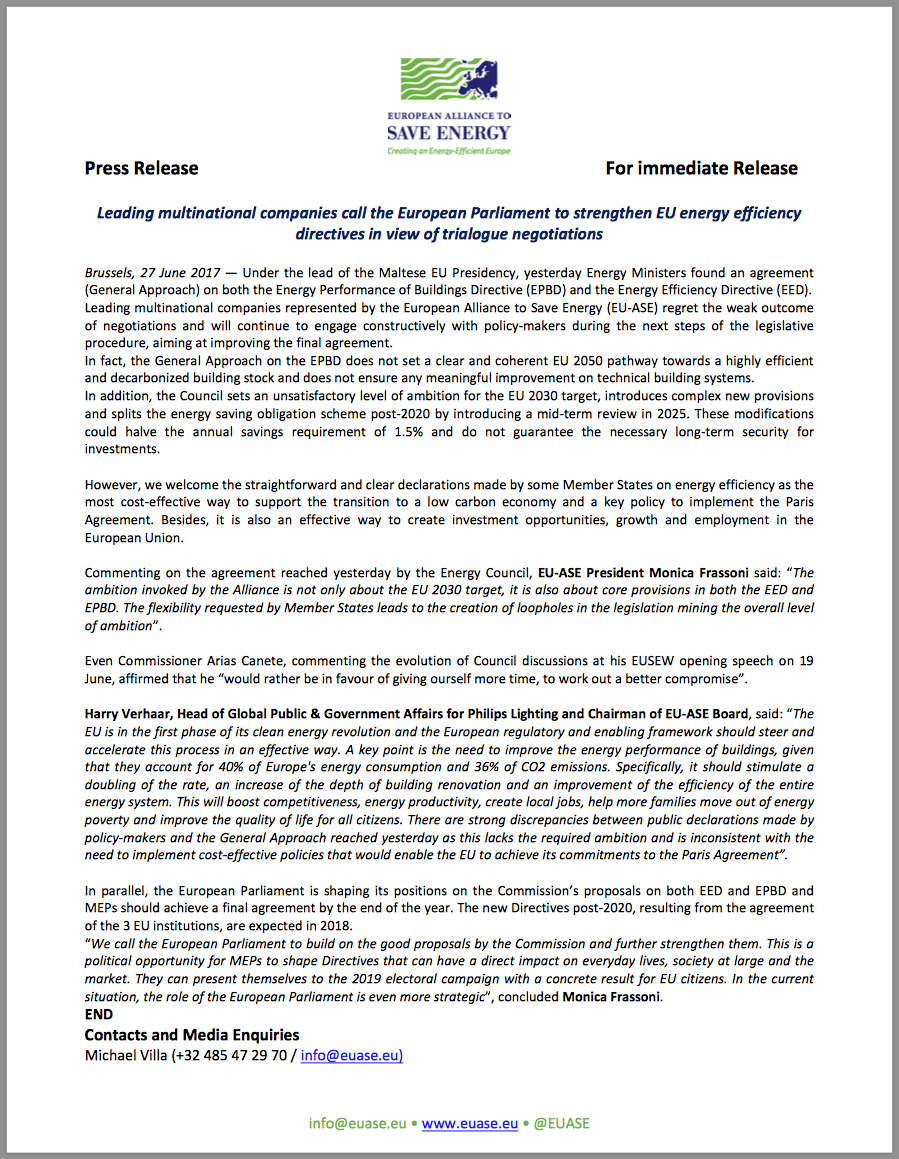
Brussels, 27 June 2017 — Under the lead of the Maltese EU Presidency, yesterday Energy Ministers found an agreement (General Approach) on both the Energy Performance of Buildings Directive (EPBD) and the Energy Efficiency Directive (EED).
Leading multinational companies represented by the European Alliance to Save Energy (EU-ASE) regret the weak outcome of negotiations and will continue to engage constructively with policy-makers during the next steps of the legislative procedure, aiming at improving the final agreement.
In fact, the General Approach on the EPBD does not set a clear and coherent EU 2050 pathway towards a highly efficient and decarbonized building stock and does not ensure any meaningful improvement on technical building systems.
In addition, the Council sets an unsatisfactory level of ambition for the EU 2030 target, introduces complex new provisions and splits the energy saving obligation scheme post-2020 by introducing a mid-term review in 2025. These modifications could halve the annual savings requirement of 1.5% and do not guarantee the necessary long-term security for investments.
However, we welcome the straightforward and clear declarations made by some Member States on energy efficiency as the most cost-effective way to support the transition to a low carbon economy and a key policy to implement the Paris Agreement. Besides, it is also an effective way to create investment opportunities, growth and employment in the European Union.
Commenting on the agreement reached yesterday by the Energy Council, EU-ASE President Monica Frassoni said: “The ambition invoked by the Alliance is not only about the EU 2030 target, it is also about core provisions in both the EED and EPBD. The flexibility requested by Member States leads to the creation of loopholes in the legislation mining the overall level of ambition”.
Even Commissioner Arias Canete, commenting the evolution of Council discussions at his EUSEW opening speech on 19 June, affirmed that he “would rather be in favour of giving ourself more time, to work out a better compromise”.
Harry Verhaar, Head of Global Public & Government Affairs for Philips Lighting and Chairman of EU-ASE Board, said: “The EU is in the first phase of its clean energy revolution and the European regulatory and enabling framework should steer and accelerate this process in an effective way. A key point is the need to improve the energy performance of buildings, given that they account for 40% of Europe’s energy consumption and 36% of CO2 emissions. Specifically, it should stimulate a doubling of the rate, an increase of the depth of building renovation and an improvement of the efficiency of the entire energy system. This will boost competitiveness, energy productivity, create local jobs, help more families move out of energy poverty and improve the quality of life for all citizens. There are strong discrepancies between public declarations made by policy-makers and the General Approach reached yesterday as this lacks the required ambition and is inconsistent with the need to implement cost-effective policies that would enable the EU to achieve its commitments to the Paris Agreement”.
In parallel, the European Parliament is shaping its positions on the Commission’s proposals on both EED and EPBD and MEPs should achieve a final agreement by the end of the year. The new Directives post-2020, resulting from the agreement of the 3 EU institutions, are expected in 2018.
“We call the European Parliament to build on the good proposals by the Commission and further strengthen them. This is a political opportunity for MEPs to shape Directives that can have a direct impact on everyday lives, society at large and the market. They can present themselves to the 2019 electoral campaign with a concrete result for EU citizens. In the current situation, the role of the European Parliament is even more strategic”, concluded Monica Frassoni.
